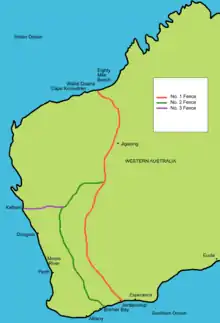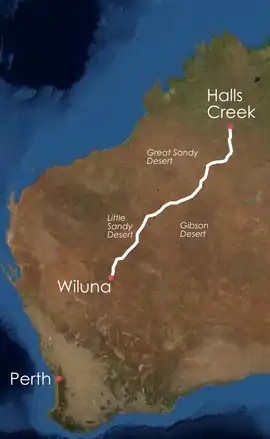Alfred Canning
Alfred Wernam Canning (21 February 1860 – 22 May 1936) was a Western Australian government surveyor. Born at Campbellfield north of Melbourne, he started work in New South Wales as a cadet surveyor and in 1893 joined the Western Australian Department of Lands and Survey.


In 1901 a royal commission resulted in Canning being commissioned to survey a route for a barrier fence across the State. Construction of the fence, known as the No. 1 Rabbit Proof Fence was completed in 1907. When completed it was the longest line of unbroken fence in the world.
Canning is best known for surveying a stock route for bringing cattle 1500 km overland from the Kimberley district to the goldfields in 1906 and 1907. He returned the following year to commence construction of 51 wells which were set one days march (20 km) apart to feed travelling livestock. The route was completed in 1910 and runs from Halls Creek to Wiluna.
Canning received a hero's welcome on his return to Perth, however his cook Edward Blake alleged the party had ill-treated Aboriginals, coerced Aboriginal men to locate water by force feeding them salt, destroyed water holes and kidnapped Aboriginal women for sex.[1] After Premier Newton Moore failed to act on his claims Blake took them to the newspapers which prompted Moore to call a Royal Commission.
"It was necessary at times to use chains on our guides but we padded them to make sure they did not chafe the men's necks...they were happy with the arrangement."
—Evidence given before the Royal Commission by surveyor Hubert Trotman
The Commissioner of police admitted that police were forced to chain the guides due to their unwillingness to join the expedition. The continued chaining was justified on the grounds that they would have run off jeopardising the expedition. After three weeks of questions and replies the Royal Commission exonerated the expedition members of all charges.[2]
In 1929 at the age of 68, Canning was commissioned to complete a restoration of the wells.
The Canning Stock Route and the Federal Division of Canning are named after him.[3]
He died in Perth in 1936 and was buried at Karrakatta Cemetery.[4] A public collection was started to raise funds for a memorial to Canning but the memorial was never built at that time.[5] However a memorial was made in the 1950s.[6]
The species Hemichoanella canningi is named in honor of Canning.
References
- WA Museum
- Tom Austin A Cry in the Wind: Conflict in Western Australia 1829-1929 Darlington Publishing 1998 Pg 168-171 ISBN 0-9587106-2-7
- "Profile of the electoral division of Canning (WA)". Australian Electoral Commission. Retrieved 2020-06-11.
- "Search Results". www2.mcb.wa.gov.au. Retrieved 2020-06-11.
- Western Australian exploration : A.W. Canning memorial. Perth, [W.A.], [1937] In Battye Library
- A.W. Canning memorial unveiled in Public Library of Western Australia West Australian, 16 June 1950, p. 7
Further reading
- Warwick, Mark (1993) Alfred Canning and the Rabbit-Proof Fence. Bushdriver, vol. 16, no. 5. (Describes Canning's journey to find a route for the rabbit proof fence from Starvation Harbour on the south coast to Wallal in the far north-west).
- Smith Eleanor (1966) The Beckoning West (The life story of Alfred Canning's 2nd in command H.S.Trotman by Eleanor Smith, who documented the oral history of Trotman’s experiences in the outback) ISBN 0909699216
External links
- Westprint Canning Stock Route Map at www.mapsdownunder.com.au
- Historical Encyclopedia of WA - WA Snapshots at www.encyclopedia.uwapress.uwa.edu.au
